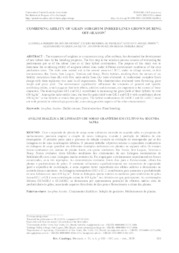Combining ability of grain sorghum inbred lines grown during of season.
Combining ability of grain sorghum inbred lines grown during of season.
Author(s): GOMES, L. R. da R.; MENEZES, C. B. de; SIMON, G. A.; SILVA, A. G. da; BRAZ, A. J. B. P.
Summary: The expansion of sorghum as a succession crop, after soybean, has demanded the development of new inbred lines by the breeding programs. The first step in the selection process consists of evaluating the performance per se of the inbred lines or of their hybrid combination. The purpose of this study was to determine the combining ability of sorghum inbred lines under different environment conditions of the crop production areas. The trials were carried out in the second season of 2017, under no-tillage system, in four environments, Rio Verde, Sete Lagoas, Teresina and Sinop. Thirty hybrids, resulting from the crosses of six fertility restoration lines (R) with five male-sterile lines (A) were evaluated. A randomized complete block design with three replicates was used in all experiments. The characteristics evaluated were flowering, plant height and grain yield. The environment significantly influenced the estimates of general and specific combining ability, which suggests that both effects, additive and dominant, are important in the control of these characters. The restoring lines GI.1 and G1.2 contributed to increasing the grain yield of their hybrids by over 650 kg.ha-1 . Among the male-sterile lines, the best for grain yield were GII.1 and GII.4 with contribution above 450 kg.ha-1 in the hybrids in which they participate. The hybrid combinations GI.5xGII.3 and GI.1xGII.2 stood out with potential to obtain high grain yield, associating positive aspects of the other characteristics.
Publication year: 2020
Types of publication: Journal article
Unit: Embrapa Maize & Sorghum
Keywords: Cruzamentos dialélicos, Genitor, Melhoramento Vegetal, Safrinha, Seleção, Sorgo
Observation
Some of Embrapa's publications are published as ePub files. To read them, use or download one of the following free software options to your computer or mobile device. Android: Google Play Books; IOS: iBooks; Windows and Linux: Calibre.
Access other publications
Access the Agricultural Research Database (BDPA) to consult Embrapa's full library collection and records.
Visit Embrapa Bookstore to purchase books and other publications sold by Embrapa.

